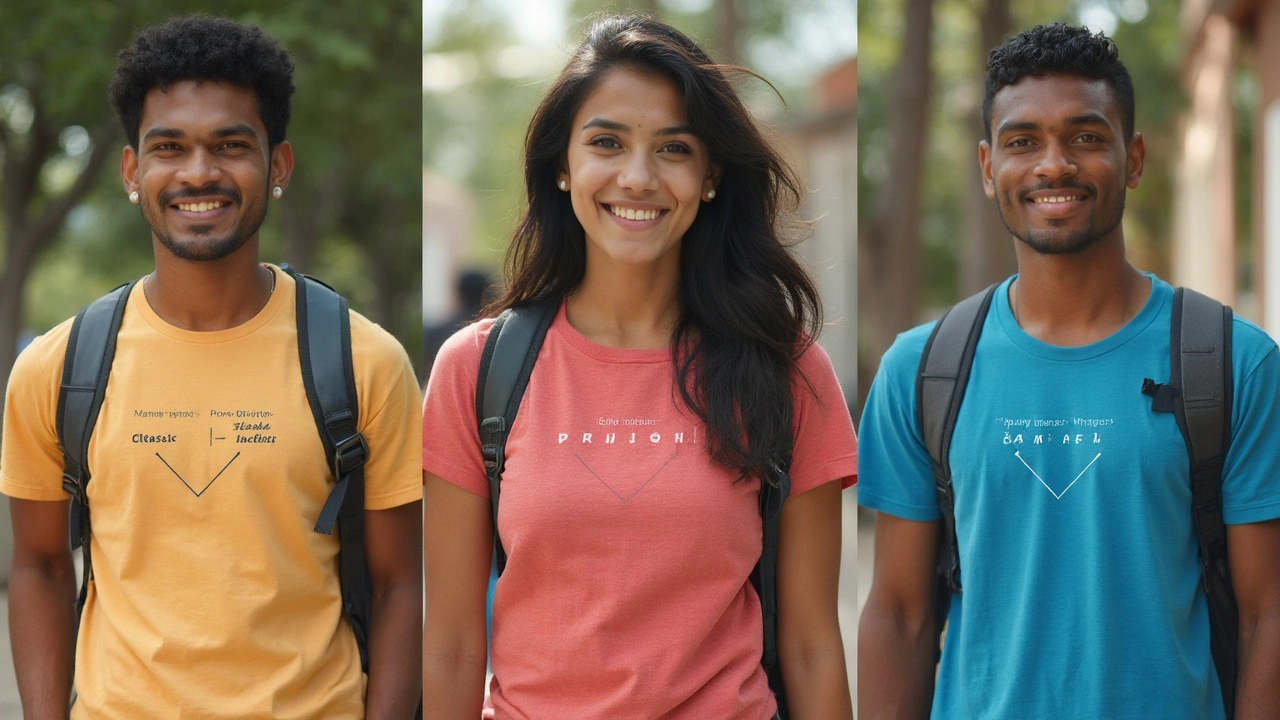Ever pulled on a t-shirt that went saggy or scratchy after just one wash? Yeah, me too. The fabric makes all the difference in whether that tee lands in your 'favorite' pile or the bottom drawer. If you're tired of shirts that fade, shrink, or just don’t feel right, it's time to get smart about material.
The secret to a great t-shirt often comes down to what it’s made from, not just the brand on the label. You don’t need to be a fashion expert to spot the good stuff—just a few key facts can save you money (and closet space) in the long run. Ready to see which fabrics shine and which to avoid? Stick around; let’s make your next t-shirt your best one yet.
- What Makes a T-Shirt Material 'High Quality'?
- Cotton: The King (With a Twist)
- Blends and Emerging Fabrics
- How to Spot Quality When You Shop
- Is Expensive Always Better?
What Makes a T-Shirt Material 'High Quality'?
Let’s cut through the hype: the highest quality t-shirt material has three things locked down—feel, durability, and breathability. When you pick up a shirt, it should feel soft and smooth, not rough or stiff. If it hugs your skin without itching or clinging, you’re on the right track.
Durability shows up after a few weeks. Good shirts hold their shape, don’t shrink into baby sizes after a wash, and stay bright instead of fading out. Materials like pima cotton or ringspun cotton last way longer thanks to their longer fibers. They also resist pilling (those little fuzz balls nobody likes).
Comfort matters, but so does breathability. If you’re sweating bullets in a t-shirt, you’ll notice if the fabric traps heat. Cotton is famous here—no surprise that about 60% of all t-shirts made worldwide use it, according to the International Cotton Advisory Committee.
- Softness: Long-staple fibers like those from pima or Egyptian cotton clinch this one.
- Weight: Light to mid-weight fabrics feel nice but aren’t see-through. Heavier shirts can last, but they get hot quickly.
- Weave: Look for tight, even knits. Loose or uneven textures break down fast.
- Blends: Some fancy blends mix cotton with modal, bamboo, or a smidge of polyester for strength and stretch. Just check the percentage—too much synthetic, and the shirt loses its breathability.
| Material | Main Advantage | What to Watch Out For |
|---|---|---|
| Pima Cotton | Soft, strong, hardly pills | More expensive |
| Ringspun Cotton | Smooth, durable | Sometimes thin |
| Polyester Blend | Adds stretch, less wrinkling | Can trap sweat, feel plastic-y |
Bottom line: the best fabric for t-shirts is soft but strong, keeps its color, lets your skin breathe, and survives wash after wash. Checking the label for fiber type and feeling the knit with your hand will tell you a lot more than the logo ever could.
Cotton: The King (With a Twist)
You’ve probably seen cotton on more t-shirt tags than any other word, and there’s a reason for that. Cotton feels soft, breathes well, and just works for everyday wear. But not all cotton is the same—there’s a big difference between cheap stuff and the kinds that really last.
The real heavy hitters are types like Pima cotton and Supima cotton. These are extra-long staple cottons, which means the fibers are longer and stronger. That translates to a t-shirt that feels smoother, holds color better, and resists piling (those annoying little lint balls). Typical supermarket or “basic” cotton shirts usually use shorter fibers, which break down faster and get rougher with every wash.
- Pima cotton mainly comes from Peru and is known for softness and durability.
- Supima cotton is grown in the US, and it’s basically pima but held to even stricter standards. Less than 1% of the world’s cotton gets the Supima label.
Organic cotton is worth a mention, too. The quality can be just as high as regular premium cotton, but it’s grown without harsh chemicals. That’s better for your skin and the planet, so it’s a solid choice if you care about eco-friendliness.
If you’re ever in doubt about cotton quality, check the tags and look for these buzzwords: “long-staple,” “Pima,” “Supima,” or “organic.” Skip anything that just says “100% cotton” without other details if you want your tee to go the distance.
| Type | Fiber Length | Feel | Durability |
|---|---|---|---|
| Regular Cotton | Short/Medium | Ok, gets rougher | Average, pills quick |
| Pima/Supima Cotton | Extra-Long | Super soft | High, resists pilling |
| Organic Cotton | Varies | Smooth if long-staple | Good, eco-friendly |
So if you’re looking for high quality t-shirts that don’t bail out on you after a few months, aim for those higher-end cottons. They might cost a bit more upfront, but trust me—you’ll get more wear for your dollar.

Blends and Emerging Fabrics
So, you’ve probably seen labels that read "cotton-poly blend" or "tri-blend" and wondered if these are just marketing lingo or the real deal. Here’s what’s up: fabric blends are everywhere in the t-shirt material game, and they exist for good reasons—mostly to boost comfort, fit, or durability.
The big player is cotton-polyester. Mix pure cotton with polyester, and you get a shirt that’s tougher and dries faster than 100% cotton. This is the go-to for athletic tees because it wicks sweat better and shrinks less. If you hate wrinkles or iron as little as possible, blends will be your friend. But keep in mind, not all blends are created equal—cheap blends can feel stiff or develop pills (those annoying fuzz balls) after a few washes.
If you see "tri-blend" on a tag, it means the shirt mixes cotton, polyester, and usually rayon. People love these for their soft, vintage feel and how they drape—not clingy, not boxy, just relaxed. A lot of your favorite band tees are probably tri-blend, if you check the tag.
Then there’s Modal and Tencel—both made from plants, but with a high-tech twist. Modal comes from beech trees and is insanely soft, almost silky. Tencel (sometimes called Lyocell) is made from eucalyptus trees and resists odors and bacteria. These materials are getting lots of hype for being comfy and a bit more eco-friendly than basic synthetics.
| Fabric | Main Benefits | Common Uses |
|---|---|---|
| Cotton-Poly Blend | Durable, wrinkle-resistant, quick-dry | Everyday tees, sportswear |
| Tri-Blend | Soft, stretchy, vintage look | Casual tees, graphic shirts |
| Modal | Super soft, holds shape, breathable | Premium tees, underwear |
| Tencel/Lyocell | Moisture-wicking, sustainable, odor-resistant | Athletic tops, eco-conscious fashion |
When hunting for the best fabric for t-shirts, don’t skip over blends—they might surprise you with how good they feel. Just watch out for blends with a high percentage of cheap synthetic fibers; those are the ones that end up feeling plasticky and not breathing well. Opt for shirts with clear fabric breakdowns on the tag, so you know exactly what you’re getting.
How to Spot Quality When You Shop
Buying a high quality t-shirt isn’t a guessing game if you know what to check. Forget fancy ads—focus on the facts you can see and feel.
The first thing to check is the tag. Is the shirt 100% pima cotton or SUPIMA®? That’s a good sign—it’s softer, less likely to pill, and more durable than regular cotton. If it’s blended, see what it’s mixed with. Don’t write off polyester entirely, but make sure any cotton vs polyester blend leans heavier on the cotton side for comfort.
Feel the fabric. Pinch it—if it snaps back into shape and feels smooth with a little weight, that’s what you want. Flimsy, thin, or see-through shirts just don’t last. Top-notch t-shirt material should stay looking and feeling solid after many washes.
Ever noticed tiny twists or ripples at the side seams of cheap tees after a few washes? That’s lousy construction. Check the stitches: Double-stitching or reinforced seams mean the shirt won’t fall apart on you. Tug on the seams gently—a quality shirt holds up, while a lower quality one will stretch or split.
- Look for tight, even stitching. Loose threads or uneven seams are big red flags.
- High quality tags or tagless printing usually mean more attention to detail.
- Smooth, even coloring means better dye and less risk of fading.
If you can, ask for density or weight info. A sweet spot is around 5-6 oz per square yard for everyday wear. Too heavy and it’s bulky, too light and it’s almost see-through. Some brands list this info online or on tags.
| Material | Expected Lifespan (Washes) | Comfort Rating (1-10) |
|---|---|---|
| SUPIMA® Cotton | 50+ | 9 |
| Regular Cotton | 30-40 | 7 |
| Polyester Blend | 40-50 | 6 |
Don’t fall for the idea that super high price means super high quality. Some of the hardest-wearing, softest tees don’t cost much more than a few coffees. Trust your hands and eyes, not just the hype, next time you shop for best fabric for t-shirts.

Is Expensive Always Better?
Price tags on t-shirt material can get weird. You’ll see some designer tees running over $100, while fast fashion brands offer three-packs for less than lunch money. So, does a higher price mean higher quality?
Not necessarily. Sure, luxury brands may use superior cotton like Pima or Supima, but a chunk of what you're paying for is the name and some flashy marketing. There are $15 tees out there that beat $80 ones for softness and durability. It's all about what’s in the shirt, not the logo stitched on the sleeve.
If you dig deeper, you’ll find this insight everywhere. The Business of Fashion once summed it up:
"A high price doesn't always guarantee high-quality fabric. Many mid-priced brands use the same cotton mills as luxury houses."In other words, that luxury price often pays for brand hype, not just material.
Let’s lay it out: high-quality t-shirts usually share certain features, no matter the cost.
- Made from long-staple cotton fibers (Pima, Supima, Egyptian)
- Consistent, tight knit for smooth feel
- Reinforced seams and durable collars
- Little to no shrinkage after washing
The real catch? Sometimes, brands mix these traits into even budget-friendly tees. And—heads up—lots of expensive tees use blended or synthetic fabrics too. That isn’t always bad (blends can fight wrinkles and sweat), but it’s worth checking the label before paying up.
Here’s a straightforward comparison of what you often get by price bracket:
| Price Range | Materials Used | Quality Features |
|---|---|---|
| Under $20 | Standard cotton, some blends | Basic stitching, may shrink/fade |
| $20-$50 | Combed cotton, occasional Pima/Supima | Softer, more durable, better construction |
| $50+$ | Premium cottons, designer blends | Reinforced details, softer finish, branding |
The trick is to check the tag, touch the fabric, and look at the stitching. Don’t let price alone do the talking; sometimes the perfect high quality t-shirts hide in plain sight, not behind a heavy price tag.

